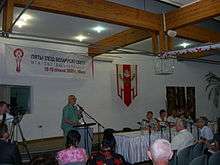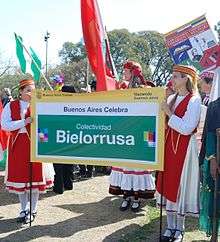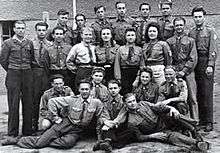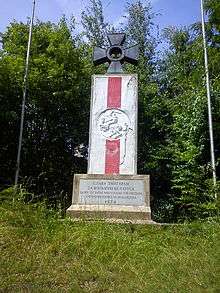Belarusian diaspora
Belarusian diaspora refers to emigrants from the territory of Belarus as well for people of Belarusian descent.

According to different researches, there are between 2.5 and 3.5 millions of people of Belarusian descent living outside the territory of the Republic of Belarus. This number includes descendants of economic emigrants from Belarus of late 19th century and early 20th century, of emigrants of times of the Second World War and emigrants of the wave that started in the 1990s. Another group of Belarusian diaspora are people who migrated within the USSR before 1991 and who after its dissolution became inhabitants of other post-Soviet countries. A separate group usually associated with the Belarusian diaspora are ethnic minorities in the borderlands of Belarus with Poland, Lithuania and Russia.

A separate group of emigrants from Belarus were Belarusian Jews who have established significant communities in the United States and Israel. The historic name for Belarusian Jews were Litvaks, a corrupted term of Litvin or "Lithuanian" in Belarusian.
There is a tendency to a decline in the number of people identifying themselves as Belarusians according to official censuses.
The biggest and best organized Belarusian diasporas live in Russia (including Siberia), Ukraine, Poland, the USA, Canada, the UK, the Baltic states (i.e., Estonia and Latvia), Central Asia (primarily the Soviet-era Farming settlement program in Kazakhstan) and the TransCaucasus nations (i.e., Armenia and Georgia).
There are small Belarusian communities in Scandinavia, Germany, Netherlands, France, Spain, Portugal and Ireland as a result of European Union and Council of Europe contract labor agreements to recruit Belarusian and Ukrainian workers in the late 2000s.
The World Association of Belarusians based in Minsk is the international organization uniting people of Belarusian descend from around the world. The government of the short-lived Belarusian Democratic Republic is in exile since 1919 and acts as a consolidating centre for many politically active Belarusians abroad, especially in North America and Western Europe (i.e., Canada, United Kingdom, Belgium).
History
Many Belarusians were forced out of their homeland in the eighteenth and nineteenth centuries. The earliest Belarusians immigrated in the seventeenth century to Netherlands and America under pressure of Roman Catholic and Eastern Orthodox Counter-Reformation in Belarus. Belarusians migrated to Siberia and the Far East after their lands were occupied in the eighteenth century by the Russian empire. Throughout the nineteenth century this continued.
In 1863-64 the Belarusian immigrants had a massive arrival into the United States because their freedom failed being led by Kastus Kalinouski and therefore were crushed by tsarist armies. Religious persecution and campaign of russification got very serious shortly after. Between 1880 and 1920, many people from Belarus moved to the US. Jewish Belarusians and Belarusian peasants caused a massive wave of immigration to USA due to extreme poverty in Russian Empire Western province. Belarusians continued immigrating in the 1920s through 1930s during Stalin’s repressions.[1]
At the end of World War II was the second big wave of immigration. This was a mix of people, "who were running from Soviets, victims of pre-war Stalin’s repressions, some Nazi collaborators and thousands of young Belarusian forced laborers who stayed in Europe after WWII." Most of these Belarusian immigrants moved to United States, Canada, Australia and Brazil while some stayed in Germany, France, and UK. After the USSR fell apart, the third wave began to come in from the 1990s and still continues today. It began as a wave of "socio-economical" immigration and turned into "political asylum" escapees when President Lukashenko dictatorship matured in the last few years. Most of the people immigrated to countries of the European Union, USA, Australia, Canada and lately even Russia. The latest wave of immigration from Belarus consists of professionals such as software and other engineers, scientists, students and sportsmen.
In 1949, the Government of the Belarusian Democratic Republic in exile has prepared an estimation of the total number of Belarusian migrants in the main countries of Belarusian emigration. The numbers include pre-war immigrants, mostly from West Belarus, as well as persons identifying themselves as Russian or Polish:[2]
| Country | Number of Belarusian immigrants as at May 1, 1949 |
|---|---|
| United States | 500,000 |
| Argentina | 100,000, of which 60 thousand lived around Buenos Aires |
| Canada | 30,000 |
| Great Britain | 11,000 |
| Brazil | 10,000 |
| France | 10,000 |
| West Germany | 10,000 |
| Belgium | 1,500 |
| Australia | 500 |
| Austria | below 500 |
| Venezuela | 150 |
| Sweden | 100 |
| Italy | 50 |
| Denmark | 50 |
Europe
France
Several thousand Belarusian refugees and soldiers of the Anders' Army landed in France after World War II. They established a Belarusian cultural and religious centre in Paris.

Germany
After World War II many Belarusians came as Displaced persons to Germany. From 1945 to 1950 there was a Belarusian Secondary School in Germany in Regensburg named after Yanka Kupala.[3] In 1948 Belarusian emigrants created a monument to the participants of the Slutsk Defence Action in Mittenwald.
Great Britain
Several thousand Belarusian refugees and soldiers of the Anders Army landed in Great Britain after World War II. They established a Belarusian cultural and religious centre in London. In 1971 the Francis Skaryna Belarusian Library and Museum was founded. Nowadays it is the largest Belarusian library outside Belarus.
Latvia
According to the latest Latvian population census, currently there are 76,600 Belarusians in the country, who form 3.5 per cent of the total population of Latvia; 41,300 of them have non-citizen status. The majority of Belarusians live in large towns such as Riga, Daugavpils, Liepāja, Ventspils, and Jelgava as well as in small towns of the Latgale region. About 70 per cent of the students at the Riga Janka Kupala School are ethnic Belarusians. The republic of Belarus has assisted in the development of this school since many Belarusian citizens reside in, and attend the school in Riga. Latvia has a number of Belarusian public organizations with a goal to promote the Belarusian culture, language and traditions, to preserve the national identity of the Belarusians in Latvia. These Belarusian organizations hold events to promote the traditions, culture and language of Belarus.
Lithuania
According to censuses of early 20th century, Belarusians consisted a majority in the region of Vilnius. As the capital of the Grand Duchy of Lithuania, the city has historically been the centre of Belarusian cultural life. In 1939 the region of Vilnius was transferred to Belarus, but later was given away to the Republic of Lithuania. Nowadays there is only a small Belarusian minority in Lithuania, consisting primarily of Soviet times migrants and post-Soviet emigres, including political refugees. The Belarusian and Polish-Lithuanian communities sought more representation in the Lithuanian government, as well the mass movement of Belarusian contract laborers via Poland into Western Europe in the 2000s.
Poland
Poland is home to a shrinking Belarusian minority that was part of the larger Białystok Voivodeship; annexed by Joseph Stalin in 1939 and incorporated into the Belarusian SSR, and only returned to Poland after World War II. Aside from that, a stream of Belarusian immigrants has been coming into Poland from the 1990s, including political immigrants and Belarusian Poles. Now there are also Belarusian communities in larger cities like Warsaw and Krakow.
Russia
The Belarusian minority in Russia consists mainly of emigrants from Belarus during Soviet times and the times of the Russian Empire as well as of remainders of the indigenous Belarusian population of the regions of Smolensk and Bryansk, now largely assimilated. According to official 2002 census, over 800 thousand Russians identified themselves as people of Belarusian descent. The number drastically declined from over 1 million just a decade before (the 1991 Soviet Census) due to processes of assimilation, and factors affecting the population decline in Russia such as low birthrate and high death rate caused by the economic hardships of the 1990s. Most Russian Belarusians live in Moscow, St. Petersburg and Siberia.
.jpg)
Ukraine
In Ukraine, the number of Belarusians is estimated at over 275,000 (the 2001 Ukrainian Census)[4] Most of the Belarusians diaspora in Ukraine appeared as a result of the migration of Belarusians to the Ukrainian SSR during the Soviet Union. Lviv has been an important center of Belarusian social and cultural life during the Russian Empire and interwar Poland. There are now Belarusian organizations in major cities like Lviv, Sevastopol in the Crimea, and others. A notable Ukrainian of Belarusian descent is Viktor Yanukovych, the fourth president of Ukraine.
North America

Canada
Belarusian immigrants have been coming to Canada since the 19th century. An other wave of refugees came after World War II. It is difficult to estimate the real number of Canadians of Belarusian descent because immigrants from Belarus were often classified as Poles or Russians (sometimes Lithuanians, i.e., Litviny), or sometimes as Ukrainians. According to the 2011 Census there were 8,050 Canadians who claimed Belarusian ancestry.[5]
United States
Belarusian immigrants have been coming to the US since the 19th century. A large group of Belarusian immigrants from Belarus were Belarusian Jews, who came to the country in late 19th century and early 20th century. An other wave of refugees came after World War II. It is difficult to estimate the real number of Americans of Belarusian descent because immigrants from Belarus were often classified as Poles or Russians (sometimes Lithuanians, i.e., Litviny), or sometimes as Ukrainians.
The largest concentrations of Belarusian Americans are in the metropolitan New York area, New Jersey (especially Highland Park and South River), Cleveland (and its suburbs), Chicago (recent immigrants concentrated around Wheeling), Los Angeles, and Detroit.
South America
Argentina
The First organized Belarusian diaspora in Argentina appeared in the 1st half of the 20th century. The Belarusian diasporas count between 10 and 20 thousand people. Almost all Belarusian immigrants of that time came to Argentina from Poland-occupied West Belarus. Unlike in other western countries, Belarusian organizations in Argentina were pro-Soviet and fell under influence of the Soviet embassy. There was a wave or repatriation to the Belarusian SSR in 1956.[6]
References
- ↑ "Belarusian Diaspora in Latvia." - Embassy of the Republic of Belarus to the Republic of Latvia. Web. 23 Apr. 2015. <http://latvia.mfa.gov.by/en/bilateral_relations/compatriots/>.
- ↑ Hardzijenka, Natallia; Jurevic, Liavon (2013). "Фактычныя дадзеныя аб стане беларускае эміграцыі (паводле справаздачы прадстаўнікоў Ураду БНР на 01.05.1949)" [Factual data on the state of the Belarusian emigration (according to the report by representatives of the Government of the BDR as at 01.05.1949)]. Рада БНР (1947-1970): Падзеі. Дакументы. Асобы [Rada of the BDR (1947-1970): Events. Documents. Personalities]. Бібліятэка Бацькаўшчыны (in Belarusian). Minsk: World Association of Belarusians. p. 406. ISBN 9789857089079.
- ↑ http://www.belarus-misc.org/bel-bdia.htm#ger
- ↑ http://2001.ukrcensus.gov.ua/results/general/nationality/
- ↑ Statistics Canada. "2011 National Household Survey: Data tables". Retrieved 11 February 2014.
- ↑ Беларусы ў Аргенціне
- [http://www.belarusguide.com/culture1/diversity/Belarusian_Diaspora.html> Belarusians Abroad]. Belarusians Abroad. Web. 23 April 2015
Sources
- Натальля Гардзіенка. Сучаснае беларускае замежжа: праблемы і перспектывы (даклад на V Зьездзе беларусаў сьвету) (Belarusians abroad today: problems and perspectives, report by Natallia Hardzijenka at the 5th World Congress of Belarusians in 2009)
External links
- World Association of Belarusians
- A web-portal for Belarusians in Ukraine
- Belarusian-Canadian Alliance
- The international seminar Belarusian Diaspora: Past and Present took place in Minsk